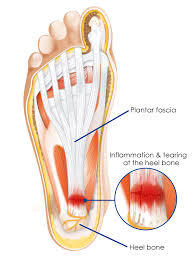
Plantar fasciitis/sole pain-what is it?
 When I spoke to Dr. Damian Roussel, Foot and Ankle Specialist at MMI, I asked him what was the most common foot and ankle complaints from the running community that he sees and without hesitation his response was “Plantar Fasciitis and Metatarsalgia.” As an avid runner myself, and considering I have had my own personal experiences with both, I decided to address the subject of Plantar Fasciitis.
When I spoke to Dr. Damian Roussel, Foot and Ankle Specialist at MMI, I asked him what was the most common foot and ankle complaints from the running community that he sees and without hesitation his response was “Plantar Fasciitis and Metatarsalgia.” As an avid runner myself, and considering I have had my own personal experiences with both, I decided to address the subject of Plantar Fasciitis.
Plantar Fasciitis is the most common cause of heel pain in runners affecting about 10% of this population. Conventional wisdom in medicine has held that plantar fasciitis was an inflammatory condition, however in recent literature that addresses this condition it is more of a degenerative process. Over time and with repeated pulling of the plantar fascia associated with excessive arch lowering and flattening can lead to chronic pain and inflammation at the plantar fascia attachment to the heel. This continued stress at the heel can set up a bone spur. This in turn causes further deterioration and degeneration of the plantar fascia. It is not the actual spur that is painful but the chronic degeneration and subsequent inflammation that is responsible for the pain in the foot.
The small foot muscles must maintain their strength to properly distribute pressure away from the overworked plantar fascia of the foot. When these foot muscles, specifically the Flexor Digitorum Brevis and Posterior Tibialis are weak foot propulsion and control is compromised. (For example the over pronating foot)
What are the symptoms of Plantar Fascitis???
- Aching, sharp or burning pain in the sole of the foot often centering in the medial heel area
- Foot pain that occurs as soon as you step out of bed or get up on your feet after prolonged periods of sitting
- Pain that decreases eventually after you have been on your feet for a while only to return later in the day
- Sudden heel pain or pain that builds up gradually
- Foot pain that has lasted for more than a few days or which you experience periodically over the course of months or years
- Pain in just one foot although it is possible to have plantar fasciitis in both feet
Who’s At Risk????
- The syndrome can affect highly active or sedentary people. It is more pronounced in the obese population
- Feet that excessively pronate-a condition in which the force and impact of standing, walking, and running is not transferred evenly from heel strike to toe off. These folks seem to roll inward on the ankles
- Overuse/over training without adequate periods of rest
- High arch, flat feet, tightness of the achilles and or hamstrings
- Long periods of time standing on cement or pavement
- Physical trauma such as a fall landing on the foot or being involved in a car accident
- Repeated hill workouts
- Runners who quickly go from a stability or motion control shoe to wearing a minimalist
Treatment suggestions???
- Arch raises exercise-sit with feet flat, hips and knees at 90 degrees, gently roll foot out to the side as you try to raise the arch of your foot. Repeat 15-20 times
- Standing calf stretch-hands on wall stretch the calf, slightly toe in the stretch more of the Achilles, hold stretch 30 seconds repeat 2-3 times
- Hamstring stretches-prop foot up on step stool, keep back straight, gently lean forward until you feel stretch to back of thigh-hold 30 seconds repeat 2-3 times
- Apply night brace to lengthen soft tissue of the calf. (Strasburg Sock)
- Manual and deep tissue massage to arch and calf
- Orthotic Inserts
- Finally a thorough Biomechanical Evaluation may be necessary that includes strength testing of hips, knees, and core. This may unveil areas of weakness that the runner may need to address.
When in doubt, questions, or for guidance, don’t hesitate to contact Dr. Damian Roussel or one of the foot and ankle therapists or podiatrists at MMI Frederick or Hagerstown.
Stay tuned for the next issue when we discuss “The menace of Metatarsalgia and Neuromas”